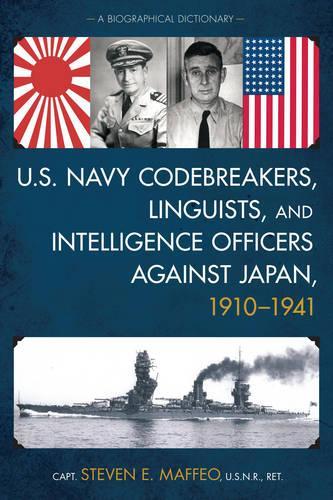
U.S. Navy Codebreakers, Linguists, and Intelligence Officers against Japan, 1910-1941: A Biographical Dictionary
(Hardback)
Publishing Details
U.S. Navy Codebreakers, Linguists, and Intelligence Officers against Japan, 1910-1941: A Biographical Dictionary
By (Author) Capt. Steven E. Maffeo
Bloomsbury Publishing PLC
Rowman & Littlefield Publishers
16th December 2015
United States
Classifications
Professional and Scholarly
Non Fiction
Naval forces and warfare
Political control and freedoms
Second World War
Modern warfare
359.34320922
Physical Properties
Hardback
574
Width 163mm, Height 233mm, Spine 46mm
993g
Description
This unique reference presents 59 biographies of people who were key to the sea services being reasonably prepared to fight the Japanese Empire when the Second World War broke out, and whose advanced work proved crucial. These intelligence pioneers invented techniques, procedures, and equipment from scratch, not only allowing the United States to hold its own in the Pacific despite the loss of most of its Fleet at Pearl Harbor, but also laying the foundation of todays intelligence methods and agencies. One-hundred years ago, in what was clearly an unsophisticated pre-information era, naval intelligence (and foreign intelligence in general) existed in rudimentary forms almost incomprehensible to us today. Founded in 1882, the U.S. Office of Naval Intelligence (ONI)the modern worlds oldest continuously operating intelligence agencyfunctioned for at least its first forty years with low manning, small budgets, low priority, and no prestige. The navys early steps into communications intelligence (COMINT), which included activities such as radio interception, radio traffic analysis, and cryptology, came with the 1916 establishment of the Code and Signals Section within the navys Division of Communications and with the 1924 creation of the Research Desk as part of the Section. Like ONI, this COMINT organization suffered from low budgets, manning, priority, and prestige. The dictionary focuses on these pioneers, many of whom went on, even after World War II, to important positions in the Navy, the State Department, the Armed Forces Security Agency, the National Security Agency, and the Central Intelligence Agency. It reveals the work and innovations of well and lesser-known individuals who created the foundations of todays intelligence apparatus and analysis.
Reviews
Though it is well known that US naval intelligence contributed greatly to the Allied victory in the Pacific War, less is known of the dedicated men who worked so long and hard to understand a complicated language and foreign culture. Each of the 59 entries has a photograph of the officer; an excerpt from his entry in The Lucky Bag, the Annapolis yearbook of the Naval Academy; and a discussion of his life and how he contributed to the effort to crack Japan's codes. These interesting details help readers understand the difficult but ultimately successful analytical work and the bitter bureaucratic battles. As expected, the book is extensively documented with excerpts from various sources, footnotes, bibliography, and references at the end of each entry. The author, a retired associate director of the McDermott Library at the US Air Force Academy, has written other books on intelligence topics. This unique tool is a much-needed tribute to these unsung heroes and can be used when researching the preWW II era and the attack on Pearl Harbor. Also available in electronic format, it is most suitable for the reference collections of academic or large public libraries. Summing Up: Recommended. Undergraduates through researchers/faculty; general readers. * CHOICE *
Maffeos book fills a longstanding gap in the literature of Navy cryptology. This volume will remain the standard reference for information about the Navys intelligence personnel before and during World War II. * Proceedings *
As a retired Air Officer and student of military history, I found Steve Maffeo s book, U.S. Navy Codebreakers, Linguists, and Intelligence Officers against Japan, 1910-1941, to be absolutely fascinatingas it will be to anyone who wants to get the true history of naval intelligence before the start of World War II. His biographies of these 59 intelligence and cryptology pioneers tell the story of how these dedicated peoplewho were underfunded, undermanned, and usually under appreciatedhelped win the eventual war against Japan. Fortunately, because Captain Maffeo has written this outstanding history, their deeds and names will live on. This is a must read. -- Steve Lorenz, General, U.S. Air Force, Ret., formerly Commander, Air Education and Training Command
Steve Maffeos new book is a winner in the fields of intelligence and cryptology before and during World War II. While other authors have dealt with the intercepted intelligence itself and its contributions to naval and military operational planning, he delves into the previously secret aspects of the process of code breaking by focusing on the people involved. By describing in considerable detail what it cost many of them as individuals, he humanizes their personal contributions to the war effort. Overall, this book will be of interest to anyone interested in pre-war and wartime intelligence and especially to students in the field of intelligence studiesas well as the descendants of the men Maffeo writes about who were forbidden to tell their own stories. In a real sense, while the details vary, their experiences reflect the pressures and demands on code breakers and intelligence officers in other wars past and present. -- John Kenneth Rowland, Ph.D., Colonel, USAF (Ret.); emeritus (program director and associate dean), U.S. National Intelligence University
A scholarly monument to the brilliant men and women who contributed mightily to the U.S. victory in World War II over Japanand helped lay the foundations for todays National Security Agency. -- Stephen Coonts, New York Times best-selling author of Flight of the Intruder, Fortunes of War, Combat, Deep Black, and America
Author Bio
Capt. Steven E. Maffeo, U.S.N.R., Ret. formerly associate director, McDermott Library, U.S. Air Force Academy.
